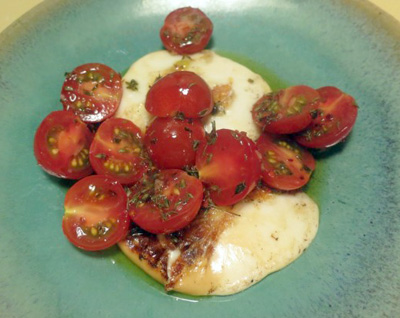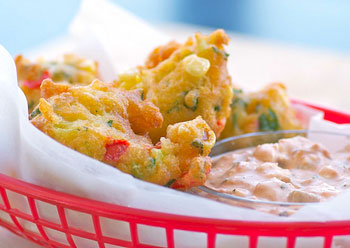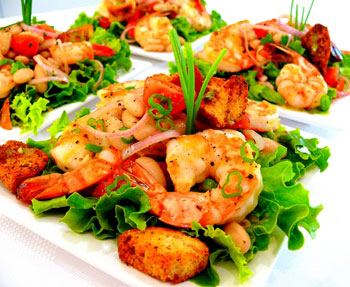 Cheese and tomatoes go together like, well, pizza. But sometimes you don’t want all that bread. Sometimes you want something satisfying, fresh, that’s hot and quick. Insalata Caprese is great, but when I want something a bit more substantial and warm I make Scamorza Affumicata alla Griglia.
Cheese and tomatoes go together like, well, pizza. But sometimes you don’t want all that bread. Sometimes you want something satisfying, fresh, that’s hot and quick. Insalata Caprese is great, but when I want something a bit more substantial and warm I make Scamorza Affumicata alla Griglia.
Or grilled smoked mozzarella topped with seasoned cherry tomatoes. It’s the easiest dinner ever.
Take a few cherry tomatoes, cut them in half and toss with good extra virgin olive oil, salt, the pepper of your choice (I love Aleppo pepper) and some oregano (I have a bunch of dried Sicilian oregano that I use by crumbling a bit into the bowl.

 If there’s one thing I learned about food while living in North Carolina, it’s that anything can be battered and fried: steak, okra, pickles. Heck, even butter, as Paula Deen, proved, can be battered and fried.
If there’s one thing I learned about food while living in North Carolina, it’s that anything can be battered and fried: steak, okra, pickles. Heck, even butter, as Paula Deen, proved, can be battered and fried. There is a restaurant in my town that serves a dish using shrimp and very large cannellini beans. It's one of my favorite things to order when I go there. However, since I rarely go out to dinner, I decided to use those two ingredients and create something I could enjoy at home.
There is a restaurant in my town that serves a dish using shrimp and very large cannellini beans. It's one of my favorite things to order when I go there. However, since I rarely go out to dinner, I decided to use those two ingredients and create something I could enjoy at home. Peaches and nectarines are kissing cousins. In fact, maybe closer. Plant a bunch of peach pits and a few of them will actually sprout nectarine trees, and vice versa. It used to be said that the difference was that peaches had fuzz while nectarines didn’t. But in supermarkets today, that’s hard to determine since many of the peaches have been mechanically de-fuzzed.
Peaches and nectarines are kissing cousins. In fact, maybe closer. Plant a bunch of peach pits and a few of them will actually sprout nectarine trees, and vice versa. It used to be said that the difference was that peaches had fuzz while nectarines didn’t. But in supermarkets today, that’s hard to determine since many of the peaches have been mechanically de-fuzzed. Strawberry Shortcake seemed to always mark the beginning of summer when I was growing up.
Strawberry Shortcake seemed to always mark the beginning of summer when I was growing up.
